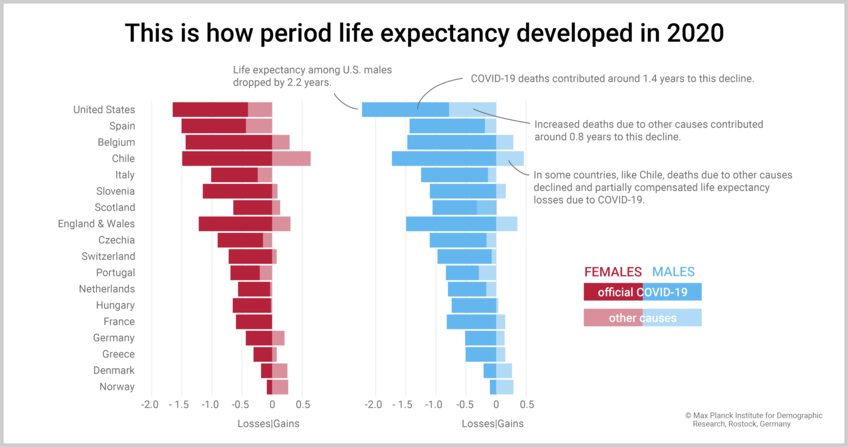Covid-19 influences life expectancy
Period life expectancy drops significantly due to pandemic
Jonas Schöley, Researcher at the Max Planck Institute for Demographic Research and an international team of demographers calculated that period life expectancy in European countries and the United States dropped by several months or even years in 2020 due to the Covid-19 pandemic. Men in the U.S. lost the most, an average of 2.2 years. In Germany, by contrast, period life expectancy for both men and women has fallen by only a few months.

In Europe, average life expectancy has consistently been increasing every year by a few weeks or a few months for decades. The Covid-19 pandemic has halted this development; from 2019 to 2020 period life expectancy fell in 27 of the 29 countries studied in Europe and the Americas.
Men in the United States and Lithuania had the greatest decrease in life expectancy. Their period life expectancy fell by 2.2 and 1.7 years, respectively. Overall, for men, period life expectancy fell by more than one year in 11 of the 27 countries studied. For women, it fell by more than one year in 8 countries. “These figures underscore the historic scale of the pandemic,” says Jonas Schöley, a research scientist at the Max Planck Institute for Demographic Research (MPIDR) in Rostock, Germany.
In Germany, period life expectancy fell by just under three and a half months
Denmark and Norway were the only countries studied where the period life expectancy of men and women did not fall. There, the numbers of Covid-19 deaths were low by international standards. At the same time, mortality from other causes of death continued to decline, so the period life expectancy actually increased slightly in Denmark and Norway in 2020.
Germany has also seen a decline in other causes of death, though it is lower than in Denmark and Norway and the number of Covid-19 deaths is higher. As a result, period life expectancy in Germany in 2020 fell by just over four months for men and two and a half months for women.

In most countries, period life expectancy wiped out gains in life expectancy seen in the five years before the pandemic. “In many Western European countries, such as Spain, England, Italy, Belgium, France, the Netherlands and Sweden, losses of this magnitude haven’t been seen since World War II,” says Jonas Schöley.
Together with colleagues at the University of Oxford and the University of Southern Denmark, Schöley calculated the period life expectancy for the year 2020, based on the timely published publication of weekly death counts in numerous countries. Schöley and the team used datasets compiled by MPIDR researchers in the STMF database and the COVerAGE database. The team published their study in the International Journal of Epidemiology.
Period life expectancy says nothing about lifespan of 2020 births
Period life expectancy reflects the risk of death a population faced within a year. If the risk of dying in a year increases, such as from a heat wave or from COVID-19 infection, life expectancy decreases; if the risk of dying decreases, life expectancy increases.
“Period life expectancy is particularly suitable as a comparative measure in the pandemic,” says Jonas Schöley. “This is because it is not influenced by the age composition and size of the population,” he adds. “What is decisive during the pandemic, on the other hand, is the infection rate and the overall state of the health care system.”Although it’s called life expectancy, from the data you can not infer the influence of the pandemic on the average life span of children born in 2020,” says Jonas Schöley.













